|
|
Tiny Town Review
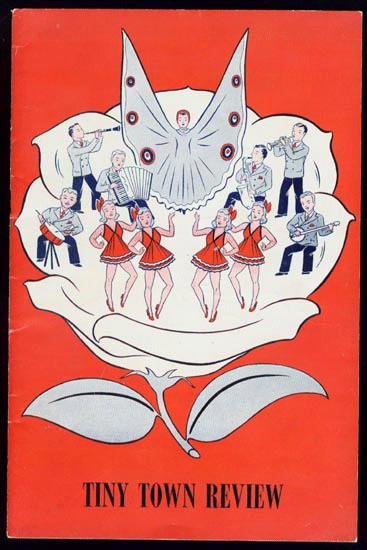
A relic of a politically incorrect time
A souvenir stage show program featuring numerous black and white photographs; publisher unknown, but featuring the article “Little by Little: Why is a Midget and What’s His Life Like? Come Visit a Troupe
of Them, and a Woman Who Guides Their Destinies” by John Proctor, as originally printed in The Family Circle; 32 pages, circa 1938.
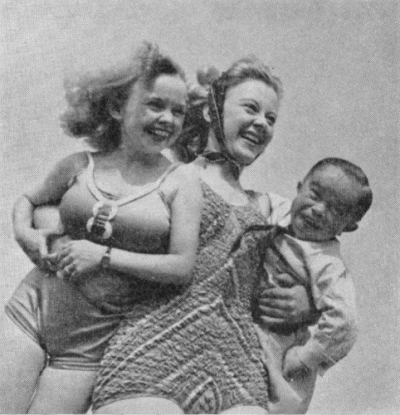
MIDGETS: The World’s Population is rated at 2,000,000,000
of which it is estimated there are only 2,000 Midgets
There’s only “ONE IN A MILLION”
Thus was the lucky audience introduced to the Tiny Town Review. But wait! There’s more:
Direct from International Triumphs
IN PERSON -:- ON THE STAGE
PARISIAN
MIDGET FOLLIES
The World’s Greatest and Most Gorgeous
MINIATURE MUSICAL REVIEW
featuring
A LARGE COMPANY OF AMAZINGLY TALENTED SINGING AND DANCING “LITTLE PEOPLE”
with
THE ONLY MIDGET SWING BAND IN EXISTENCE
THE MITE MAGICIAN
THE SMALLEST LIVING HILL BILLIES; FAN DANCERS; BALLETS AND COLORFUL, THRILLING ENSEMBLES.
A THRILL FOR YOUNG AND OLD
A ZIEGELDIAN STAGE PRODUCTION IN MINIATURE!!
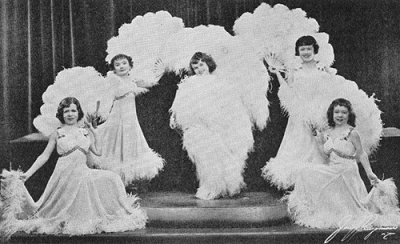
Okay, okay, I’m sold already. If one can’t believe two exclamation points, what can one believe?
Once upon a time average folks flocked to see troupes of performing little people. On the understanding that more is better, little people were clustered en masse into ‘midget villages’ for World Fairs, featured in terrible novelty films such as the infamous Terror of Tiny Town (the first — and I hope last — “all midget western”), and even more of them were on the road performing in side shows and stage reviews. One such production was The Tiny Town Parisian Midget Follies, the souvenir program from which I will describe here.
The majority of this program is taken up with a rather long article that had been published in The Family Circle (the magazine from which the appalling comic strip takes its name, I suppose).
Presumably, the audience attending The Parisian Midget Follies had a lot of time to read up between acts, for John Proctor’s “Little by Little” goes on for fifteen pages. The gist of the text is,
“Gee whiz, ain’t midgets neat? They’re so tiny, but they’re just like real people — only more adorable.”
The reader is lead to understand that the “ingratiating miniature performers” have been corralled under the tutelage of the smiling Carla Rose, who “inherited the troupe when her famous showman
husband, Ike Rose, died four years ago.” Excuse me — inherited?!
Lest the reader think of Mrs. Rose as a cruel slave mistress, Proctor reassures that she is “far more than a manager. Her midgets look upon her as their confidante and advisor.” Oh, well, that’s nice.
He goes on to say, “Ten of them live right in her apartment,” [they are small, after all, so they could not possibly take up too much room] “and the last time I spent an evening there, Mrs.
Rose was elated over the acquisition of two sisters, Adela and Florence Nowak, whom she had lately discovered in the hinterland of Nanticoke, Pennsylvania.” At this point I’m getting a bit uneasy over all this talk of ‘acquisition’, but it does not seem to faze Carla Rose:
I am not going to mention names, or even localities… but I have my eye on several little people who are something very special in the line of midgets — one of them no larger than a one-year-old
child — and the slightest hint might serve to lose them for me. Midgets are not so scarce as you might think… but picking those who are both extra-small and sufficiently talented to be coached for the
stage is something else again.
Apparently this woman had a keen eye for midget flesh, but she did not have to locate her performers all on her own:
Many little people are brought to me by their parents… and when my troupe was at the Texas Centennial, I was astonished to find how many midgets there are in that part of the country. Dozens
appeared for a tryout… Sometimes word gets around about a particularly talented midget in a remote part of the country, and sometimes people send me tips by mail. Right now I have a waiting list of 35.
Mrs. Rose, despite the language that now makes us uncomfortable, was merely doing what thousands of showmen had done before her. In fact, she and many performers believed she was performing a great service:
The entertainment field offers midgets their best chance for contentment, and so I find that parents are usually willing to entrust their offspring to me. No, we don’t sign any
contracts. The Rose name is so well known that I am able to take the children on the customary conditions — that I pay the parents a certain amount of salary, give the midgets pocket money, and take care of their
traveling and living expenses…
Apparently, a little person could really live on the cheap back in the day, but according to the terms on which Mrs. Rose paid her performers getting a decent meal required some management:
I give each member a dollar a day for meals. They generally eat in pairs, and although their appetites are larger in proportion to their size than those of normal persons, they can
make out very well with a regular table d‘hote lunch or dinner. One of the pair eats the fruit cocktail, and the other takes the soup, and the next day they will reverse the order. They share the meat and dessert
courses, and most restaurants are accommodating about providing extra plates, as it attracts business to have midgets as customers. But the little people hate to be stared at while they eat, although
I’m afraid that is a penalty suffered by all show people who are at the mercy of their public. And for the same reason they dread going shopping in large stores.
Rose’s performers especially hated being tagged with the term dwarf, just as most little people today hate the word midget. As Proctor tries to fallaciously explain, “For some reason the
popular mind associates the midget with the dwarf simply because both are short of stature. But there the similarity ends. The dwarf is definitely a freak of achondroplastic type, with a misshapen body and sometimes a grotesque head. He is a luckless creature. The midget, on the other hand, is a perfectly formed miniature of people of normal height, and he arouses interest and admiration rather than pity.” Proctor goes on to discuss three classes of midgets in true pseudo-science fashion, but luckily there is a handy guide in the back of the program discussing how to tell a dwarf from a midget — but more on that later.
The article goes on to profile some of the troupe’s star performers, such as married couple “Midge Potter, the suave little master
of ceremonies, and Luz Villalobos, fan dancer extraordinary.” Lest anyone think Ms. Villalobos to be a woman of loose morals, she would “like to remind you… that although it may look as if I haven’t
anything on when I do my fan dance, it’s because the dance is done in blue light, and I really wear a garment.” So there, you lecherous creeps. There were other sultry performances to be seen, however,
such as the act of Mary Ellen Burbach, “probably the loveliest midget in the United States.” Proctor describes Burbach and her act thusly:
She is 18 years old, 45 inches high, a singer, dancer, contortionist, roller skater, and imitator, doing a take-off on Mae West, which I think is far more entertaining [than] the original. Her billing as ‘The Pocket-size Mae West’ is regarded as a compliment by Mary Ellen, but these old eyes have been peering at ol’ Diamond Lil in the flesh ever since her burlesque and small-time vaudeville days — beginning around 1914 — and if there ever was any resemblance between the hefty Mae and the dainty, soft-skinned, fragile little Mary Ellen, it must have been some day when I was out to lunch.
Other entertainments included the baggy-pants comedy act of Vance Swift (who also did a burlesque parody of Villalobos’s fan dance in a red union suit), a torch singer, a magician, and “the only midget swing band.” In all, the Parisian Midget Follies promised a “55-minute revue… as gay and rollicking as many presented by full-size artists.” However, one is left to wonder what marks this extravaganza as distinctly Parisian.

After Proctor’s piece, the reader is treated to a selection of photographs of the headliners, and further articles to educate about the wonderful world of miniature performance. One such feature is “It Also Happens to Midgets” which claims “Thrilling personal experiences are not entirely reserved for full grown men and woman, but also fall to the lot of midgets or ‘little people’, as can be attested by the diminutive members of the Parisian Midget Follies, the colorful stage attraction.” Golly! See, they are just like the rest of us — only smaller. It makes one wonder if midgets ever suffer sunburn or constipation.
After a column’s worth of further gee-whizzery recounting acts-of-God that have befallen some of the performers (remember: It also happens to Midgets), the article takes a sudden odd turn to focus on the performers’ eating habits:
Midgets don’t sit in high chairs to eat their meals — and they don’t eat prepared baby foods. They eat the same sort of food that we all enjoy — these teeny, weeny people — the only difference being in the startlingly diminutive portions which they consume… These folks are so very, very tiny that many persons suppose they must live on foods adapted to extremely young children.
On the contrary, most midgets are distinct epicureans, demanding the very highest culinary skill in the preparation of their food. While the quantities they consume are virtually infinitesimal, the quality must be faultless or they will register their dissatisfaction in no uncertain manner.
Vance Swift, the comical midget magician…, is quite an extraordinary culinary expert aside from his ability to perform feats of legerdemain. When he gets a chance, he loves to arrange and plan special menus from soup to nuts, and fully as cleverly as any chef two or three times his size – Vance is only a little over thirty inches tall.
[Gosh! His powers are equal to a chef of up to ninety inches tall.]
[Swift’s] favorite recipe is paprika quail, which usually forms the piece de resistance of the banquets he arranges. His concoction of celery hearts stuffed with caviar also are a gourmet’s delight.”
Vance Swift, “the smallest midget in America”, also played the xylophone, built model aeroplanes, and excelled at bridge. His greatest ambition was to meet Franklin D. Roosevelt.
Mary Ellen Burbach, the aforementioned Mae West impersonator, also played a mean game of bridge or pinochle, aspired to be a cowgirl on a big ranch, and — when at home in Chicago and not foiling kidnapping attempts by gangsters — raised tropical fish.
But what of this midget swing band we’ve been hearing about? Whither the half-pint Tommy Dorseys?
Swing music has finally penetrated the realm of midgets or the world of ‘little people‘. Jean Palfi, the 53 inch miniature Paul Whiteman featured with the Parisian Midget Follies, is probably the only musician of his size who is acclaimed a master of the new form of jazz and also a triple-tongue cornet virtuoso.
Playing here with his swing band combination, little Jean also is a proficient performer on the violin, piano, xylophone and saxophone. For ten years before he came to America, he studied under the tutelage of Maestro Josef Carlino in Budapest, after which he made his professional debut with a musical specialty in Alphonse Gerson’s Midget City in Paris.
One of Palfi’s ambitions is to sit in with a typical New York ‘jam’ or ‘swing’ session, playing with such outstanding ‘hot’ players as Benny Goodman, Joe Venuti, Phil Napoleon, Frankie Trumbauer and Jack Teagarden.
The headliner was Luz Villalobos, “a little Mexican Senorita [sic] who hails from Chihuahua, Mexico. This little lady is an expert when it comes to dancing and castanets, she is the fascinating spanish [sic] type, a buxom beauty and adds a lot of charm and talent to the program.”
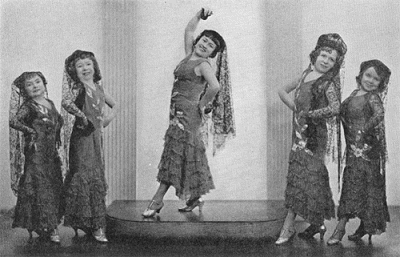
Okay, that’s a lot of information — much of it contradictory — about the lives, loves, and habits of these small folk. In case the audience still wasn’t sure what to make of all this, the good
people behind the Tiny Town Review provide a further handy guide on page 23:
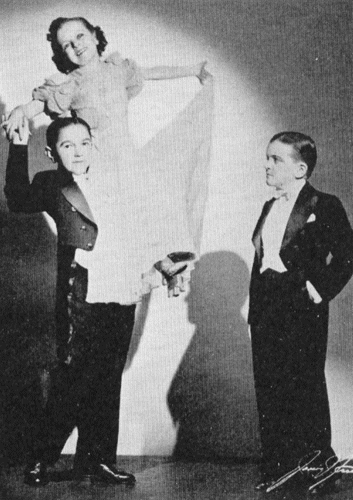
MIDGET – DWARF – PIGMY – LILLIPUTIAN
WHAT IS THE DIFFERENCE?
A MIDGET is a reproduction in miniature of a perfectly proportioned normal human being, whose greatest height is four feet six inches, and whose smallest known measurement is one foot seven inches.
A DWARF is a person stunted in growth, but generally thought of as having some deformity.
A PIGMY is the next classification in height to a Midget, ranging from four feet six inches to four feet eleven inches. The PIGMY is racial and begets its own kind, thus propagating and perpetuating the PIGMY race, while Midgets seldom give birth to Midgets.
A LILLIPUTIAN is the inhabitant of Lilliput, a fabled country created in the mind of Jonathan Swift in his classic “Gulliver’s Travels”, a political satire. The LILLIPUTIANS were diminutive people in this work of fiction, and their name has come to be broadly used for Little People anywhere.

JUST IN CASE YOU WONDER WHY
Question: Why are Midgets Midgets?
Answer: In some cases the thyroid gland is very small, permitting the child to grow only until the gland is used up. Then the actual growth of the child stops, but the brain continues to develop the same as in normal people.
In other cases the responsibility rests with the pituitary gland, lying in a depression of the skull and attached to the base of the brain. When this gland does not develop properly, growth is halted and we have Midgets.
Question: Are there different classifications of Midgets?
Answer: Yes, there are three classifications – the Primordial Midget, the Infantile Midget, and the True Midget.
Question: How do these differ?
Answer: The Primordial Midget is a Midget at birth, generally of normal parents. Except for stature, he develops in sex and mind like a normal person.
The Infantile Midget is normal at birth and develops mentally but rarely sexually.
The True Midget is born normal, develops normally in mind and sex, except that the age of puberty is in the late ‘teens or early twenties.
Question: How do Midgets grow?
Answer: Normal mankind cease to grow in the early twenties as the bone ends close. The Primordial or born Midget reaches his extreme height at twenty-five and never grows after that age, as his bone ends close like those of a normal person.
In the Infantile and True Midget classifications, both are born normal, the growth is generally retarded at or before the fifth year, after which Midgetism occurs.
Midgets of both of these classes sometimes grow amazingly after thirty, as their bone ends are not closed. Although they may grow into the Pigmy class, they seldom if ever reach normal height. The period when abnormalities occur in growing is “the age of onset”. One develops into a Midget or a Giant, generally before puberty and more often under the age of five.
Question: Is Midgetism inherited?
Answer: Midgetism is not supposed to be hereditary, as cases of Midgets from generation to generation are seldom if ever known. Midgets rarely beget their kind. Any normal person may give birth to a Midget or a Giant.
Question: What quantity of food do Midgets eat?
Answer: Because Midgets’ metabolic rate is one and a half times that of normal individuals they must eat and drink more in relation to size to maintain sufficient energy. A Midget may eat one-twenty-fifth of his entire weight at a single sitting, and drink enough liquid to provide a bath. They can often “drink under the table” a normal person.
PLENTY OF SUN AND FRESH AIR
Another Question frequently asked is ‘How do Midgets keep so physically fit and strong?’
The best answer is that they are well looked after and that they look after themselves well. Further, they are all encouraged to take as much advantage of the sun and air as possible.
The Midgets are all sun-bathers, and they never miss an opportunity of getting a sun-bath or a swim. During the summer they go out in parties and find a secluded spot where they can play games and swim
with the minimum amount of clothing.
This educational brochure, having just introduced the idea of midget nudists, continues with a litany of famous personalities down the annals of Migetdom. Finally, the Tiny Town Review closes with another informative section entitled “Can Midgets Have Babies?” Really, people, weren’t you paying attention?!
- J.M.
|

|

|

|
All Images and Text © James G. Mundie 2003 - 2010
|

